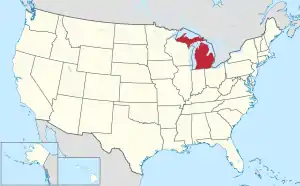United States presidential elections in Michigan
Following is a table of United States presidential elections in Michigan, ordered by year. Since its admission to statehood in 1837, Michigan has participated in every U.S. presidential election, although they did participate in the 1836 election and receive electoral votes. Michigan is tied with Pennsylvania and Wisconsin for the longest active streak of voting for the winning candidate, last voting for a losing candidate in 2004 when they backed John Kerry.
 | |
| Number of elections | 47 |
|---|---|
| Voted Democratic | 17 |
| Voted Republican | 28 |
| Voted Whig | 1 |
| Voted other | 1[lower-alpha 1] |
| Voted for winning candidate | 34 |
| Voted for losing candidate | 13 |
Winners of the state are in bold. The shading refers to the state winner, and not the national winner.
Elections from 1864 to present
Election of 1860
The election of 1860 was a complex realigning election in which the breakdown of the previous two-party alignment culminated in four parties each competing for influence in different parts of the country. The result of the election, with the victory of an ardent opponent of slavery, spurred the secession of eleven states and brought about the American Civil War.
| Year | Winner (nationally) | Votes | Percent | Runner-up (nationally) | Votes | Percent | Runner-up (nationally) | Votes | Percent | Runner-up (nationally) | Votes | Percent | Electoral Votes |
|---|---|---|---|---|---|---|---|---|---|---|---|---|---|
| 1860 | Abraham Lincoln | 88,481 | 57.2 | Stephen A. Douglas | 65,057 | 42.0 | John C. Breckinridge | 805 | 0.5 | John Bell | 415 | 0.3 | 6 |
Elections prior to 1860
| Year | Winner (nationally) | Votes | Percent | Runner-up (nationally) | Votes | Percent | Other national candidates[lower-alpha 2] |
Votes | Percent | Electoral Votes |
Notes |
|---|---|---|---|---|---|---|---|---|---|---|---|
| 1856 | James Buchanan | 52,139 | 41.52 | John C. Frémont | 71,762 | 57.15 | Millard Fillmore | 1,660 | 1.32 | 6 | |
| 1852 | Franklin Pierce | 41,842 | 50.45 | Winfield Scott | 33,860 | 40.83 | John P. Hale | 7,237 | 8.73 | 6 | |
| 1848 | Zachary Taylor | 23,947 | 36.8 | Lewis Cass | 30,742 | 47.24 | Martin Van Buren | 10,393 | 15.97 | 5 | |
| 1844 | James K. Polk | 27,737 | 49.75 | Henry Clay | 24,375 | 43.72 | - | 5 | |||
| 1840 | William Henry Harrison | 22,933 | 51.71 | Martin Van Buren | 21,096 | 47.57 | - | 3 | |||
| 1836 | Martin Van Buren | 7,122 | 56.22 | William Henry Harrison | 5,545 | 43.78 | various[lower-alpha 5] | - | - | 3 |
See also
Notes
- Theodore Roosevelt, 1912.
- For purposes of these lists, other national candidates are defined as those who won at least one electoral vote, or won at least ten percent of the vote in multiple states.
- Won the electoral college while losing the popular vote
- Was allied with a slate of unpledged electors in Louisiana, Mississippi and South Carolina
- Three other candidates ran and received electoral votes nationally as part of the unsuccessful Whig strategy to defeat Martin Van Buren by running four candidates with local appeal in different regions of the country. The others were Hugh Lawson White, Daniel Webster, and Willie Person Mangum. None of these candidates appeared on the ballot in Michigan.
References
- "Presidential Election Results: Biden Wins". The New York Times. 3 November 2020. Retrieved November 15, 2020.
- 2016 official Federal Election Commission report.
- 2012 official Federal Election Commission report.
- 2008 official Federal Election Commission report.
- "Federal Elections 2004: Election Results for the U.S. President, the U.S. Senate and the U.S. House of Representatives" (PDF). Federal Elections Commission. May 2005.
- "2000 Presidential Election Statistics". Dave Leip’s Atlas of U.S. Presidential Elections.
- "1996 Presidential Election Statistics". Dave Leip’s Atlas of U.S. Presidential Elections. Retrieved 2018-03-05.